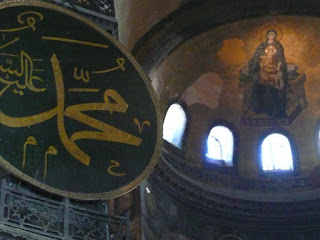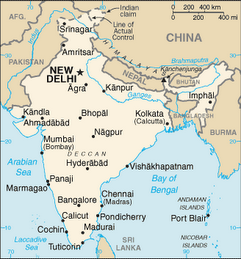
After two weeks in transition between West and East, moving from Paris to Prague to Istanbul to Bahrain to Dubai, I've arrived in Hyderabad, India, a fast-growing city on the Deccan Plateau of Southern India. My trip was a truly amazing journey that facilitated the cultural shift from West to East as I prepare for my three months working in India. Each city offered a deeper immersion in foreign culture as I journed the 8404 miles distance from Palo Alto.
In Paris I stayed with my sister in an apartment near Hotel de Ville in the heart of Paris. It was amazing to see Paris through the familiar eyes of a student and resident. We watched an amazing Chopin concert in a 12th-century cathedral, attended class at the Sorbonne, went for an 8-mile Christmas morning run across Paris and under the Eiffel Tower, and indulged a bit in life on both sides of the Seine. After about a week in Paris we set off for Istanbul via Prague. Thanks to practicing Russian greetings with my iPod Shuffle Russian podcasts, I was able to offer the kindly "Zdravstvuite" to the man next to me on the plane. He smiled.
Istanbul is a decidedly Western city that, in many parts, feels quite European. While probably not a sufficiently deep perspective to comment on its EU candidacy, it was interesting to engage citizens on the topic and get their opinions. For those interested in a cultural biography, I would recommend reading about Ataturk, the father of modern secular Turkey. In the 1930s he instituted revolutionary changes including moving away from Arabic to Roman script, outlawing religious marriage for civil, banning the purdah and other forms of traditional Muslim dress, moving the capital from Istanbul to Ankara, and giving women the right to vote. He's lauded the city over, and has the role of a more-contemporary George Washington in Turkey. Istanbul's skyline is a melange of East and West, a mosaic of minarets and domes, towers from the crusades, and Roman walls to keep out the Huns. The city is host to the Blue Mosque (6 minarets, one short of the one in Mecca), and the Aya Sofia. The Aya (or Hagia) Sofia is a fascinating juxtaposition of Christianity and Islam, as it became a mosque in 1453, nearly 1000 years after its construction. It has both the mihrab, the prayer wall that faces Mecca, and mosaic pictures of Christian figures. One example of this is in a photo.
Dubai is a deeper mix of East and West. While Istanbul feels European with influence from the East, Dubai feels like the Middle East with influence from the West. Its shopping malls create startling mixes of women in purdah carrying Dior shopping bags, men in the Gutra (red/white Bedouin scarf) drinking Starbuck's lattes, while Aussies in shorts smoke Sheesha on the Persian Gulf. I took a desert safari with me and six Iranians who only spoke Farsi. Unfortunatly I did not know more than a dozen overlapping Arabic words that provided our only common tongue. My one week base in Turkish provided me the skill set to decipher transliterated Arabic menus and speak stupidly with my Iranian tour mates. A drive down the road to Oman followed by three hours over dunes left us in a Bedouin world of sand and camels, sheesha, kebabs and a lone bellydancer in the Arabian night.
Madinat Jameriah, Dubai
“Alone in Arabia”
A warren of shops
Narrow passages, good spilling luxurously into the walkway
Trays, brass camels, inlaid-wooden boxes
Arab men sail over tiles
Women in black veils next to Brits to the nines
Casual intersection of culture
East and West
West and East in a whirl of smoke
Sheesha puffs
In long bubbling inhalations
Minty plastic and throat tickles
A sip of tea and another round of hot coals
Smiles and crooked teeth
Melange of accents, Indian, Italian and British
Arabic chatter
Salaam meets ciao
Garmets unfurled to the tile
Gliding sandals over a tapestry
Persian or Turkish
And the belvedere that is now
Timeless views of eras juxtaposed
Traditional modernity
Golden windtowers afront the purplish glow of the Burj al Arab
Strike a pose
Strike the flash
Capture the glow of the night that is Arab
That is casual
Ephemeral as smoke
A transient minty mist that dissipates
Bursting bubbles on tea and in pipe
Reveals a starry sky
Glittering gulf
Persian and foreign
Yet a moon that hovers the same
An obsever
Silent in the Arabian night
Only one thousand more
Adventures to come
--
I've now arrived in Hyderabad and have settled into my apartment. The Hyderabad office is vertical, much like New York, with an interesting vista over a developing sub-tropical skyline. The weather is quite warm and balmy, and the roads are sheer insanity. The days are presenting themselves in small challenges. Showering, telephones, and internet are, unfortunately, still surprisingly difficult.


